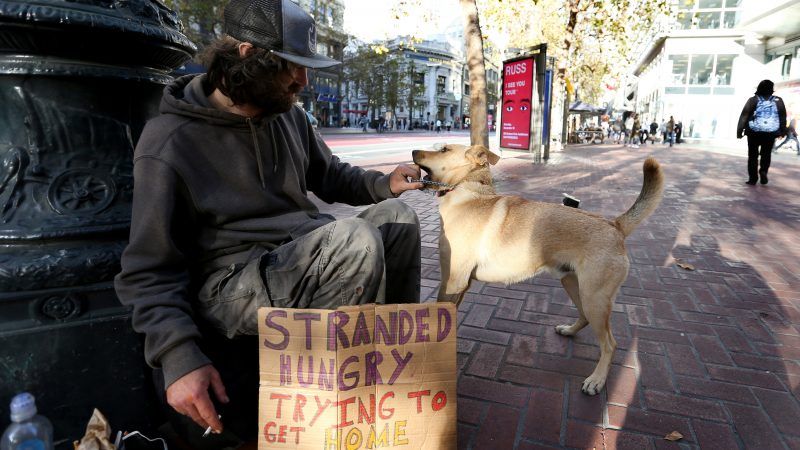While Homeless Population Balloons, San Francisco Residents Use Environmental Lawsuit to Stop Homeless Shelter
Yet another neighborhood group is using a California environmental regulation to stop a housing project they don't like.

In the most played-out storyline in urban politics, San Francisco residents are alleging that a new housing development was approved without appropriate environmental review.
The development in question is a planned 200-bed temporary homeless shelter on the city's Embarcadero waterfront area. It would replace what is currently a publicly owned parking lot used by fans visiting the nearby Giants stadium.
The shelter was first proposed by Mayor London Breed back in March as part of the city's Navigation Center program, which provides temporary shelter to homeless people while they are connected to other city services.
These plans met immediate opposition from neighbors, who in, public hearings, protests, and official appeals raised objections that commonly dog proposed homeless shelters: The new shelter would bring drugs and crime to the nearby residential neighborhood. Its 200-bed size would prove too large for the city to effectively handle, particularly given its record managing other Navigation Centers. The presence of contaminated soils and groundwater at the site would create health hazards for the people who would live there.
The city's Board of Supervisors ultimately rejected these complaints, approving the Navigation Center in June. In doing so, they also declared the project was exempt from the California Environmental Quality Act (CEQA), which requires that government agencies study the environmental impacts of proposed projects before approving them.
The kind of environmental impact reports that CEQA demands cost a lot in both time and money to prepare, and would have delayed the approval of the Navigation Center by months at the very least. Because of how long and expensive these delays can be, NIMBYs frequently use the law to slow down, alter, or even stop projects they don't like.
This includes not just homeless shelters and affordable housing, but also regular market-rate developments as well.
City officials tried to avoid this problem in this case by saying that an exemption built into CEQA for urban infill projects applied to the Embarcadero Navigation Center.
But in a lawsuit filed last week, the neighborhood group Safe Embarcadero For All (SEFA) has argued that the many, many negative environmental impacts the project would bring to the neighborhood amounted to "unusual circumstances" that made this infill exemption inappropriate.
"This project will have a significant effect on the environment due to these unusual circumstances, including by attracting additional homeless persons, open drug and alcohol use, crime, daily emergency calls, public urination and defecation and other nuisances," reads the lawsuit.
Their lawsuit also argues that the state government's sign off is necessary for the Navigation Center.
SEFA is currently asking for an injunction to stop the Embarcadero Navigation Center from going forward while the case winds through the courts.
San Francisco's homelessness population has increased by 30 percent in the last two years.
This is not to say that the city's Navigation Centers have been a huge success at transitioning people into permanent housing. They haven't.
But the SEFA lawsuit is nevertheless a good example of how any response to the city's dire homelessness problem, whether its the constructions of more shelters or just the construction of more housing in general, is hamstrung by the state's onerous environmental review laws.
Rent Free is a weekly newsletter from Christian Britschgi on urbanism and the fight for less regulation, more housing, more property rights, and more freedom in America's cities.
Show Comments (69)